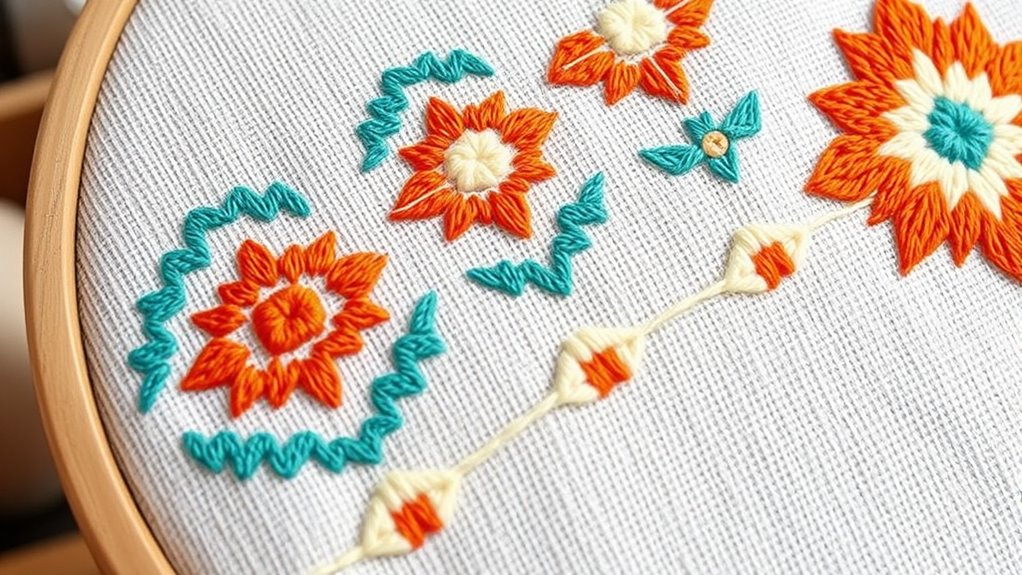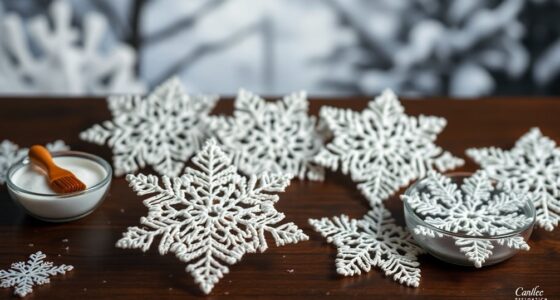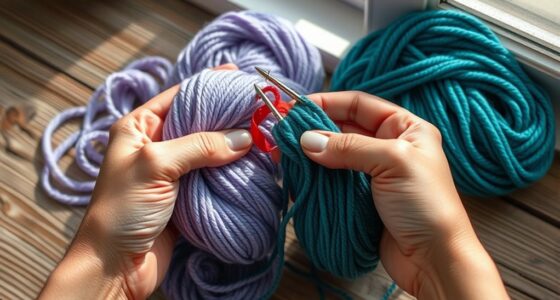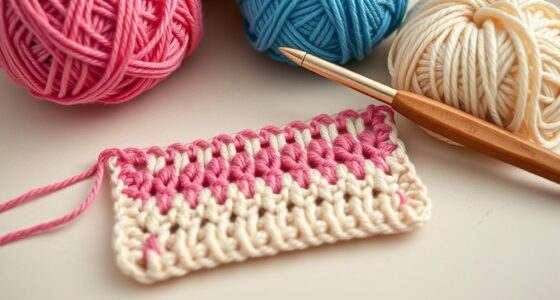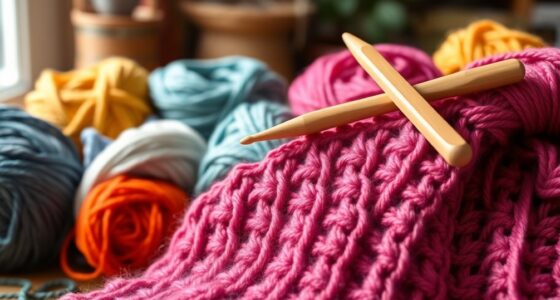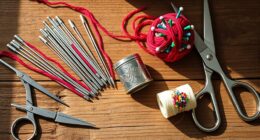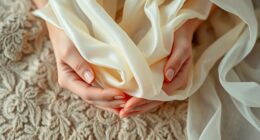To start punch needle embroidery on linen, choose the right fibers like wool or cotton based on your project. Use a sharp punch needle, a taut linen hoop, and a marking pen to sketch your design. Wool works well for a plush look, while cotton offers fine detail. Experiment with different fibers and tools to find what suits your style. Keep practicing, and you’ll discover how to create beautiful textured art with ease. If you keep exploring, you’ll uncover more helpful tips and techniques.
Key Takeaways
- Choose the right fiber (wool, cotton, acrylic) based on project texture and detail desired.
- Use a sharp, sturdy punch needle and a taut linen hoop for even stitches.
- Sketch your design onto linen with a fabric pencil before starting.
- Match fiber thickness to your punch needle size for smooth, consistent results.
- Practice on scrap linen to familiarize yourself with fibers, tools, and techniques.
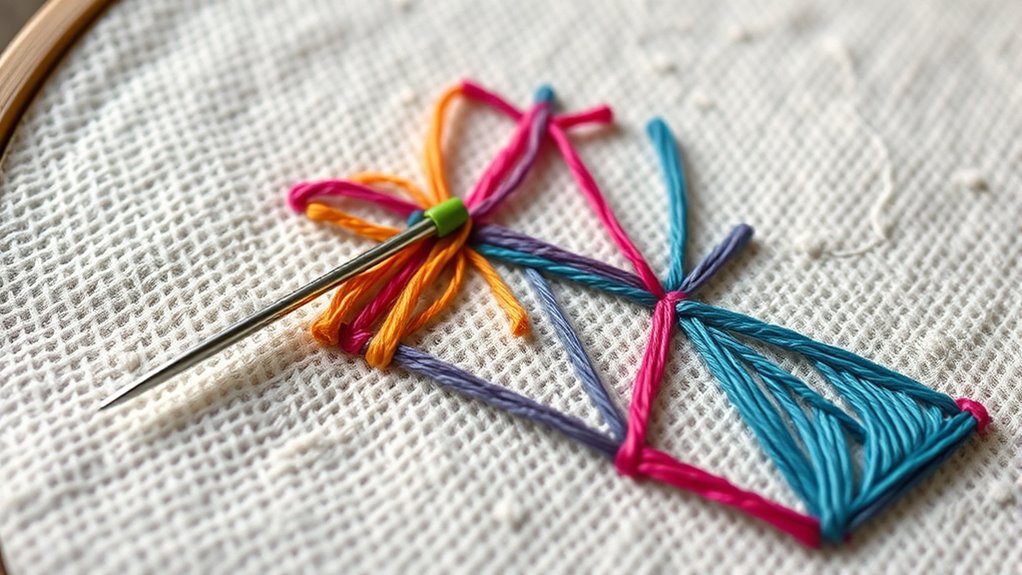
If you’re new to needle arts, punch needle embroidery is an easy and fun craft to try. It’s a great way to create textured, vibrant designs with minimal equipment. When you start, it’s helpful to understand the different fiber types available because they influence the look and feel of your finished piece. Common fibers include wool, cotton, and acrylic. Wool is popular for its plush texture and durability, making it perfect for cozy wall hangings or pillows. Cotton threads are often used for finer, more detailed work, offering a softer appearance. Acrylic fibers are versatile, affordable, and come in a wide range of colors, making them ideal for experimenting with different palettes. Choosing the right fiber depends on your project’s purpose and aesthetic, so don’t hesitate to try a few types to see which you prefer.
Equipping yourself with the right embroidery accessories will make your punch needle experience smoother and more enjoyable. Essential tools include a punch needle tool, which varies in size depending on the thickness of the fiber and the detail you want. A sturdy, sharp needle is indispensable for pushing fibers through the linen fabric without snagging or breaking. You’ll also need a hoop or frame to keep your linen taut—this guarantees even stitches and easier handling. Keep a pair of scissors handy for trimming excess fibers and a marking pen or fabric pencil to sketch your design onto the linen. As you progress, you might find additional accessories helpful, such as a thimble or finger protector to safeguard your fingers, especially when working with thicker fibers. Some punch needle kits also include a variety of yarns and threads, which can help you experiment without needing to buy everything separately. Additionally, understanding color accuracy can help you select fibers that match your desired palette more precisely.
When working on linen, selecting the right embroidery accessories and fiber types is essential. Linen’s strong, smooth surface provides an excellent base for punch needle embroidery, allowing your stitches to sit evenly and securely. Its tightly woven fibers prevent the needle from slipping through and make it easier to create detailed designs. To get the best results, you should match your fiber choice with your linen’s weave; for example, thicker wool fibers work well on a medium or heavy linen, while finer cotton threads suit lighter fabrics. Proper accessories, like a stable hoop and sharp punch needle, will help you achieve clean, consistent stitches. As you practice, you’ll discover which fibers and tools feel most comfortable and produce the look you want. With a little experimentation and the right supplies, punch needle embroidery on linen becomes a rewarding, stress-free craft that you’ll enjoy mastering.
Frequently Asked Questions
What Are the Best Linen Types for Punch Needle Embroidery?
When choosing linen for punch needle embroidery, opt for high-quality, tightly woven fabrics made from natural fibers. These linens provide better fabric durability and a smooth surface, making your stitches neater and easier to work with. Look for options like Irish or Belgian linen, which are known for their strength and longevity. Avoid loosely woven or synthetic fabrics, as they can compromise your project’s stability and overall appearance.
How Do I Choose the Right Punch Needle Size for Linen?
To select the right punch needle size for linen, consider the thread tension you prefer, as thicker threads need larger needles. Use a smaller needle for delicate, fine linen and a larger one for heavier stitches. Always store your needles properly to prevent damage. Matching your needle size to the thread and linen type ensures smooth stitching, making your embroidery easier and more enjoyable.
Can I Use Washable or Eco-Friendly Threads for This Craft?
Yes, you can absolutely use washable or eco-friendly threads for punch needle embroidery. These eco-friendly threads are designed to be durable and delightful, making your craft eco-conscious and enjoyable. Washable embroidery threads guarantee your finished piece stays beautiful through cleaning. By choosing sustainable, washable embroidery threads, you’re not only supporting the environment but also creating a charming, cheerful, and conscious creation that lasts.
How Do I Fix Mistakes or Uneven Stitches on Linen?
If you notice mistakes or uneven stitches, don’t worry. First, check your thread tension and adjust it to guarantee consistent pull. To fix uneven stitches, carefully remove the stitches with a seam ripper or small scissors, then re-stitch, focusing on maintaining stitch uniformity. Practice makes perfect, so take your time, and with patience, your embroidery will become smoother and more even.
What Are Some Advanced Techniques to Enhance My Designs?
Imagine your stitches are bland, so you add a splash of chaos—advanced techniques like textural effects and color blending can turn that into a masterpiece. You can create dimension by varying your needle pressure or layer different yarns for richness. Experiment with shading and gradients to give your designs depth. These techniques elevate your work from simple to stunning, making your punch needle embroidery truly stand out with sophisticated visual effects.
Conclusion
Now that you’ve learned the basics of punch needle embroidery on linen, remember that practice makes perfect. Don’t rush the process—each stitch brings you closer to mastery. As the saying goes, “Rome wasn’t built in a day,” so be patient and enjoy every step of your crafting journey. With time and perseverance, you’ll create beautiful, textured designs that showcase your growing skills. Keep stitching, and let your creativity flourish!
